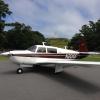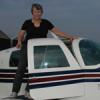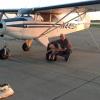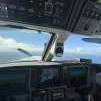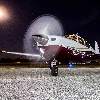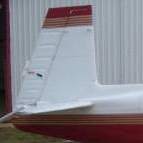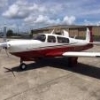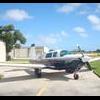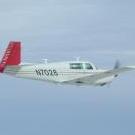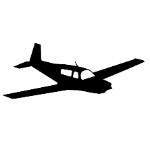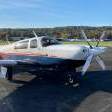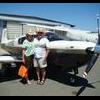Leaderboard
Popular Content
Showing content with the highest reputation on 12/20/2016 in all areas
-
A recent in-flight incident concerning a hopelessly jammed stabilizer trim on a K model prompted increased attention to an obscure Mooney Service Instruction (M20-88), and most likely a new Service Bulletin will be released soon. I have written an article that will deal with this subject in more detail in forthcoming issues of the MAPA Log and The Mooney Flyer but wanted to get the word out to the troops sooner so am posting an excerpt here. This problem may occur on K and earlier model Mooneys but here are some generalized procedures you may find useful for stab trim issues in any Mooney. Stabilizer Trim Problem Actions: Jammed Stabilizer—full nose up: The faster the plane goes the more forward elevator pressure will be required, so slow down as much as possible because this force can be considerable. Lower the flaps (takeoff or landing setting as appropriate), fly with the gear up, and use the least power needed… i.e. no need to climb quickly unless you have obstacle or terrain issues. Try to break the jammed trim loose by “shocking” the trim wheel smartly with as much nose down force (front of trim wheel towards the floor) as you can, but don’t forget to fly the plane. Declare an emergency! Pick a suitable airport (a longer runway is better). Configure normally for landing and fly a stabilized approach in the 1.2 to 1.3 VSO speed range. A slightly steeper than normal glideslope will also help. Slowly retard the throttle when landing is assured, flare, and touchdown normally. Jammed Stabilizer—mid position: Not as critical as the full nose up jam previously discussed, but it will still get your attention. It could be caused by a mechanical failure, a foreign object (e.g. rag, pen, flashlight, seat belt) getting lodged in the mechanism, or ice. Turn off Elevator Trim and Autopilot. Apply a moderate amount of manual trim in the direction opposite to that which caused the jam in the first place and consider jostling the plane in an attempt to dislodge foreign objects. (Don’t get overly aggressive—remember the Air Alaska MD-80 that tried to fix a stab trim problem rather than landing.) Land as soon as practical. If the out-of-trim condition is causing problems controlling the aircraft declare an emergency. Consider a no-flap landing (add 10 knots to VREF) if the trim is jammed nose down. Runaway Trim: Grab the trim wheel to stop the motion. The trim motor clutch will slip allowing you to restrain the wheel. Turn off the Elevator Trim switch and disconnect the Autopilot. Some airplanes have a Trim circuit breaker you can pull. Use manual trim. Be sure always to check the trim position prior to takeoff. Improperly set nose trim can make pitch control very challenging. Excess nose down trim will make rotation difficult and can result in porpoising on the runway and a possible prop strike. Excess nose up trim will make it difficult to keep climb attitude and airspeed under control. You can check your Mooney’s trim system yourself to see if it exhibits any tendency to stick at the limits. On the ground, run the trim to the full nose up position and then back slightly to see if there is any tendency to bind at the stop. Then run it to the stop again and give it “a little extra” with the manual trim wheel to see if it exhibits any tendency to stick. Check with your A&P or MSC if you have any concerns about your trim system. Lee Fox4 points
-
My turn to jump in... Hi, my name is Russ and I'm suffering from Mooney-itis... My current bird for the last 10 years is a Tripacer. It's mainly good for the local fly-ins at short grass strips and hauling the five year old grandchildren (getting them hooked early in life). I pulled the cylinders off the engine to send off for overhaul, then promptly had foot surgery; so between the two, I can only read about flying until spring time. I keep seeing older Mooneys for sale but I keep coming back to at least an F model. I figure the grandkids will only keep growing and I'd need extra legroom eventually. One of the other criterial would be electric gear, my right shoulder has been rebuilt twice and since I'm a farmer i can see me wearing it out again... I was really considering a Super Viking for a while after I did a couple ferry flights for a doctor in one, however it's a heavy bird to push in and out of a hanger by yourself and I'm not getting any younger... Right now I'm just following along everyone's Mooney stories and dreaming the fast life. I still figure I'd keep the Tripacer, I just don't see dropping in on my friend's 800 foot strip in a fast mover... Thanks for all of your postings and letting me ramble... Abilene, Kansas area Sent from my iPad using Tapatalk4 points
-
This has been a real good thread and like so many here has added to my thinking as is applies to my flying. As someone who uses a forward slip as a normal option for reasons I have mentioned and the need to fly close patterns because of tighter airports from time to time I have really been more aware about the way I fly my airplane and really thinking about wing loading angle of attack airspeed airplane loading and winds and how they have an important effect on all those things. Really want to thank all that add their experience for everyone's benefit edit and these are things I learned in basic flight training but all the different discussions over the few years here and my continued flight experience really puts them into light. A license to learn.3 points
-
Well, today I finally joined the ranks of being a "G5 pilot" (No, not that G5). Pretty slick little device and I think I'm really going to enjoy flying behind this thing. Installation was about 7 hours of work but it wasn't a straight or simple swap and drop-in replacement either. Right off the bat we could see that the lower part of the G5 unit was going to overlap the top of the Bendix/King HSI bezel. Jeff, of High Desert Avionics, was able to figure out a way to move the holes up so he could ensure a proper fit. After some drilling and filing away at the instrument hole a brand new G5 lay happily in it's new home. Total cost for parts and labor ended up being $684. I'm glad he was able to accommodate me and have the unit done in one day while I waited. If you're in the SoCal area and need good quality avionics work please consider Jeff at High Desert Avionics at Fox Field. I've always been happy with his quality of work and continue to go back up there when I need avionics work done to my plane. He doesn't make you feel like your job is too small and not worth his time, like I had at another local shop. Today I just learned how he helped out on the SpaceShip One program, working for Burt Rutan.3 points
-
I agree. I was completely OCD for a year before I bought my plane, ok still am. I had every Mooney for sale tracked and memorized. My girlfriend was totally sick of it. But she never threw down an ultimatum. Probably because she knew what the outcome would be. When I bought my plane, I bought her a nice pair of shoes and all was forgiven.3 points
-
I battled the ole fuel smell issue that started with fuel tank reseal by Weep no More, and within 2 months and through a brutally cold winter the smell was back. As I read from one of the other postings on this thread, fuel send unit gaskets was my problem. So lets add a little insult to injury, I pulled side panels ahead of the rear seat, pulled carpet back, moved insulation to the side...and when i returned from a ground trip, it was all done...well, the gaskets were replaced. So I reassembled the interior stuff and was so excited to NOT smell fuel every time I opened the door. It was only a couple months later, guess what...the smell was back again !!!! After discussing this with my AP and noticing the old gaskets lying on my tool box, it dawned on me that there were no evidence of the OLD screws. So while my AP said, "we can torque the screws again", I said, "not no, but h*ll no". So I disassembled the interior AGAIN..replaced the gaskets AGAIN...replaced the old screws with new screws (which the AP coated with some sort of thread sealer)...and I have not smelled fuel since then.2 points
-
2 points
-
Does pre-flight checking count? Maybe I'm just a geek, but I run through the pre-flight check of my KAP 150 as it is described in the FM Supplement. Takes a couple of extra minutes, but it's just something to make sure everything is working like it should. Was not doing that until I went to the Mooney Summit in 2014 and heard DMAX talk about reading your POH at least annually to learn something new about your aircraft. The A/P check was the thing I took away from my first re-read of my POH.2 points
-
2 points
-
I just sold my "Brand C" (don't ask - it was my wife's idea to get it) and I will be picking up my K model in January. Can't wait to start flying an airplane that is really fun to fly!2 points
-
For those of you who haven't tried it yet, I would encourage you to check out the CloudAhoy app and log some flights with it. It can give you valuable data about each flight such as speed and altitude profiles, ground tracks, distance flown, etc. Tonight I analyzed my last 10 landing sequences and the data was enlightening. First, my height AGL over the numbers was ALWAYS in the 20-30' range. This included fields with and without any VGSI. Not surprising, given that my brain has figured out what the appropriate approach path should look like so muscle memory just works me into that position. I'm sure you all do the same, but the consistency was still cool. Even more illuminating was the correlation between speed over the numbers and touchdown distance. If over the numbers at 65 knots, I touched down almost exactly at the 1000' mark, right on the IFR markings. Less than 60 knots had me touching down somewhat sooner of course. But the telling thing was that over the numbers at 75 knots gave me an extra thousand feet before touchdown. The extra float length isn't surprising, of course, but the consistency of it was. While I've long known the theory of it, it was neat to see the data born out in practice. What isn't in the data is wind factor for any individual flight, but averaged across all flights that gets evened out. Anyway, if you like to gather data from your flights and use it to help your understanding and your plane's tendencies, CloudAhoy is worth the $49/year in my book. Cheers!2 points
-
Congrats skates! Looks like a beautiful plane! You're going to have a blast with it! As for your question of anyone being based at KAJO, I am. Those pictures are taken right in front of my hangar... #4. I'm currently in Austin right now but I'll be home Friday. I'd be happy to meet up with you. If you need anything let me know... I can give you access to my hangar for tools, air or whatever. I fly a 66E with the same paint scheme. Is the instructor you're working with based at corona? Mike2 points
-
Although the "favorite" shops on BT will rework brand new factory TCM cylinders to make sure the valves are correctly installed. You might check out Charles Melot at Zephyr Hills FL. Powermasters in Tulsa gets very high marks too. I used Barrett in Tulsa for some of my own overhaul work and am very happy with them too. Sent from my VS985 4G using Tapatalk2 points
-
2 points
-
Pick any one. From Beechtalk it seems the factory is the best value for continental engines2 points
-
I'm pourin'. Who's thirsty? clink. Cheers. Here's to blue skies and tailwinds2 points
-
Hi cnoe It does look like you have joined the wrong crowd as this group seems to be a bunch of enablers. carry on2 points
-
Since the annual in October, my mooney has been running strong, and I was finally able to cross my 100 hour TT in ASEL milestone. I'm still such a noob, so much to learn yet, but the plane doesn't intimidate me now. I think I'm fully corrupted into the mooney religion. I'm planning for some longer trips for next year. I definitely succumbed to external pressure this weekend taking a friends father for a flight after working 19 hours the day before (it was his 70th birthday present and he was in country for only a couple days), but I was extremely deliberate and followed my checklists and didn't make any of the boneheaded mistakes I normally do. We had an awesome $100 hamburger flight, he enjoyed it immensely.2 points
-
A couple of us on Mooneyspace, Buddy and I, have completed the G-1000 WAAS STEC upgrade and the GTX345 to get ADSB IN/OUT capability. David is also investigating some of the issues we are finding as we discover the new technology. I thought I would post a couple of pictures and some findings. -GTX345R is placed in the tail where the 33 went. All of the wiring is done in the tail except one pair that has to be run through the cabin to the audio panel. If it were not for the cabin work the hours could be much less. Expect ~6-7K all in, hardware and labor. -The G-1000 MFD and software 14.02 will not display precip FIS-B weather however you get data such as TAF on the MFD -Traffic displays without issue on the MFD as well as the PFD with synthetic vision -Bluetooth on your portable device is available with the GTX345 eliminating the need for a receiver such as a Status and will display ADSB Traffic and all FIS-B weather I am interested if anyone else has installed the GTX345 with a G-1000 and if so if you can share some of your experiences. Russ1 point
-
Santa came early this year!! Closed on it Friday and the previous owner flew it out here to me in CA today. Some of you probably recognize it from a for sale thread here on MS. They are finishing up clearing out the hangar and then will be putting a fresh coat of epoxy on the floor. Hope to have her moved into her new home by Tue-Wed. It was a fun adventure searching for a plane and the whole process of purchasing this plane was a pleasure. The seller is a fantastic guy. I'll get a fun write up of the whole journey on my blog later this week but I had to come here and share the good news. Oh, any of you out at KAJO (I saw a few others on the ramp) I'd love to say hi and meet sometime.1 point
-
In VMC, separation is up to the PIC, regardless of flight plan status, advisories,flight following, etc. ATC may be given a share of the blame by the NTSB, as in last year's collision between a fighter jet on long practice approach and a C-152 in SC. In IMC on a flight plan, separation services are provided for you; in VMC, you provide your own separation.1 point
-
That thing seems to be well liked, Russ. there are plenty of reports around here somewhere... it's competition comes from vertical card devices, or the lowest cost standard compass. Best regards, -a-1 point
-
Picked up my plane after a new autopilot had been installed (non MSC shop). During the takeoff roll at rotation I discovered something was horribly wrong. The plane was extremely nose heavy and began to porpoise. It bounced back on the runway and required a very large amount of elevator pull to keep it from impacting the runway and possible prop strike. Adrenaline is a good thing! Post incident inspection revealed that the trim had been improperly reassembled resulting in two full turns of the trim wheel nose down when the trim indicator was indicating normal takeoff range! The trim was readjusted, checked, and has been fine since.1 point
-
1 point
-
BLue painted to the rear is the collator/selector The front two hoses are the mechanical fuel pump and intake sump drain big one is crankcase breather1 point
-
Then why would you not throw out the bottom speed brakes to slow down. Pull up a bit get the airspeed down to gear speed, then throw down the speed brakes. You are going to need them eventually.1 point
-
I was going to say I care, but I don't care. Instead I'll say I wouldn't trade my airplane for any other Mooney--bar none!1 point
-
I'll add to the chorus of those who say a wet rate works better than you might initially expect. While it's true different partners might fly the airplane in such a way one uses less fuel than another, those differences tend to be on the order of a few dollars and hour, and lost in the noise of other airplane expenses. If you try to "fix" this by renting dry and having everyone pay for their own fuel, the "fill it up" rule turns out to be a pain from time-to-time. Fuel pump at the home drome temporarily out of service? Long line at the pump? Tough luck, you have to hang out until it's ready, or return to the airport later and taxi back to the pump before anyone else flies the airplane. Want to take off with less than the standard fuel level to accommodate more passengers/baggage? You can't ask your buddy to skip his refuel unless you write him a check. If you fly together and split the time, you either have to run the pump twice or one of you has to write the other a check. Get an emergency message in flight? In a wet-rate partnership, you could skip the fuel-up, put the airplane away with 30+ gallons in the tanks, and no big deal. Of course, it's not a big deal in a dry rate partnership either, if everyone is reasonable, it's just more of a pain. The paramount issue isn't how you pay for gas, but rather respect, reasonableness, and an eye toward the big picture. I don't need to make every penny come out in my favor, and I wouldn't want to partner with someone who's going to gripe about a hundred dollars of differential fuel expenses over the course of a multi-thousand dollar year of aircraft ownership.1 point
-
So... do you think this means I'll have a better chance of slipping a G3X + integrated autopilot past the FSDO? I should be able to say "works fine in an RV-10" and walk out with the approval, right? Sent from my iPad using Tapatalk1 point
-
I get 800 FPM in my 231 for about as high as I want to go too. Yes the Rocket or Bravo is more, on one hell of a lot more fuel.1 point
-
1 point
-
Yep! But my CFI is out of town the end of this week for Christmas so no flying this weekend. I'm going to take the 30th off and we're going to see if we can get the rest of my dual done the 30th-31st.1 point
-
I bet posting that felt great![emoji846] Sent from my iPad using Tapatalk1 point
-
@Skates97 @teejayevans Anyone shopping for an airplane should follow this method. Undoubtedly you know more about how to value a particular model of Mooney than Vref, AOPA, or any other valuation service. It's tedious and time consuming, but when making a big purchase that has the potential to grow exponentially bigger, it's effort well spent. I did the same when searching for my C and again when searching for the 252.1 point
-
I recognize the one in Placerville from when I was looking so just checked the spreadsheet I was tracking planes on the market. It was originally in Laguna Beach and listed for $54,500 back on May 23rd. At the time it was listing 88 hours SMOH. Looks like the owner was trying to sell it back then, maybe gave up trying to go it on their own and now Skywagons is selling it.1 point
-
If you've got the bell bottom jeans, platform shoes and leisure suit to go with it, that first one is groovy. I think either one would be good if you're not planning to do any upgrading. You like the vintage look and want to keep them all original. Assuming they'll pass a pre-buy and have logs that show regular use, do it.1 point
-
I just looked in the parts manual. I may be wrong (and often am), but the washers don't seem to be correct. The drawing in the manual shows a washer on either side of the centre unit that keeps the legs of the fork spread. There's also a single washer indicated under the nut but not under the bolt head. It may be camera angle, but the left leg looks bent in slightly.... washer missing? ... and it looks dry and needing lube. Maybe i've been hanging around Clarence too much during my owner assist.1 point
-
This is what I remember being warned about the Bravo..and I consider Bob Kramer as an expert..k1 point
-
Sipping Cool Aid behind your new IFD540 & 440 will be awesome1 point
-
Looks more like a fixed gear aircraft with wheel pants to me. Edit- I'm going with Bellanca VIking1 point
-
This advice wins the "2016 best procedure award" for M20S Driver on Mooneyspace... Today, it only took 3 blades to start at 34 deg f.1 point
-
I guess it boils down to what the partners are willing to pay out of pocket for unexpected repairs versus dipping into the till. Last year we needed to have the magnetos rebuilt and all told, that cost a few grand. Then there was the autopilot repair. A few grand here and a few grand there adds up to real money. Your partners are very fortunate to have an in-house IA.1 point
-
I recently sold a half share of my 68' C to a CFII/former airline pilot. I spent plenty of time with him and people who know him making sure he would be a good fit for me and the airplane. I took the insured hull value of the airplane and divided it by two. He paid me for one half. We have an hourly operating cost of around $90/hr wet. This is based on fuel @ $6/ gallon. It includes a 2,000hr engine overhaul fund of about $23,000 and a 2,000hr prop overhaul fund of about $2,000. I have about a $6/hr fudge factor included for oil and misc. We pay out of pocket about $1,000 a year for insurance and we split the hangar rental each month, so hangar and insurance are not included in the hourly rate. Any upgrades or major parts that need to be purchased are split between the two of us and generally that money does not come from the airplanes bank account. I am an IA so I do all the maintenance and upgrades/avionics work on the airplane, which obviously saves us a ton of cash. My partner helps with the maintenance when he can, and in return I have a free CFII/MEI at my disposal. I am very fortunate because I have a great partner, he has even become a good friend now. Spend lots of time getting to know your perspective partner(s). Ask around and see what other people think about them and their flying skills. My airplane is my baby and I normally do not let anyone else fly it, but I am totally comfortable with knowing I have a solid partner I do not have to worry about.1 point
-
My take off trim is the same as hanks, but flaps are 'religiously' set for T/O... either way, some un-stick force may be required to get the nose to break free from being stuck to the ground. nose gets lifted off at 65KIAS in the O. Other things to check during the roll... (there is alist around here somewhere) MP, RPM is being delivered. FF, a back-up to the first two, also lets you know full fuel cooling is available for the climb... Airspeed alive rotate. (Don't wait for the trim to fly your plane off the ground) gear up. You won't be using the runway as you speed off over the end... Flaps up. Pretty quickly as you come upon the max flap operating speed.... fly and trim... use the yoke to set air speed for cooling in the climb. Trim to relieve the back pressure... flying by using the trim will cost you significant style points. Your CFI will explain the proper reasons for this... A slight difference in trim is a significant difference in speed on T/O. No flap take-off is usually less finicky. Flaps themselves generate a nose down force. Not using them is slightly less nose heavy. there are a few weight and wind considerations to add to this. PP thoughts, only. Not a CFI. Best regards, -a-1 point
-
Not all states collect sales tax...especially if buying from a private owner (called a casual sale). Arizona (Ken's home) isn't one of the bloodthirsty states like it's neighbor to the west... Sent from my VS985 4G using Tapatalk1 point
-
My name is Amelia, and.... Well ...you know how it is. Looking at repair estimates. Trying to convince myself that I'm too old for this foolishness. People smarter than I am are telling me my poor broken airplane will never be worth more than it is right now, in pieces, that repair is sending good money after bad. Fingers in ears. Singing lalalala.1 point
-
Hey Tony my cable will not stay attached on the fitting behind the on off knob, is that where yours was messed up. How did you ultimately fix it. The MSC recommends to make up a fitting behind the knob to keep the cable secure to the on off fitting. I've lost oxygen twice from It hopping off and the oxygen bottle not being turned off. I'm all for them fixing it but don't want a hit and miss trial. Now I'm definitely getting a backup portable system.1 point
-
Hi Mimi Well, as you may know, I have "been there, done that." I am so sorry for your experience. When it happened to me I remember sobbing to my Dad who was also in the airplane about totaling Maggie I. He said, "It is just a piece of metal. Metal can be replaced. There are no funerals being planned today." It took many weeks for me to find any solace. My Dad was also happy that I was back in the air within a week with my instructor. He said the only tragedy would be if I didn't fly again. If you need or want to talk, please reach out to me, anytime. All the best in your recovery. Jolie1 point
-
Thanks to RSHERRELL who posted a thread about an issue he was having with a Top End Overhaul. What was discovered is that Lycoming issued a Mandatory Service Advisory last year that called out a factory specific cylinder kit recall under warranty for the TIO-540-AF1B engines. Ricky (RSHERRELL) was affected by this very recently, so there may be others that could use this information. I was surprised that I had not seen this until now so I thought I would pass it along. To summarize on the AF1B portion of the bulletins, Lycoming discovered a potential casting flaw that possibly could cause a porosity issue with some factory-made cylinders that shipped with 8130 forms dated between the period of September 18, 2013 and May 28, 2015. I spoke with Frank at Lycoming this evening and as always, he and they were exceptional at proving information and guidance on this subject. Frank stressed that Lycoming’s quality assurance process identified a possible safety issue, with no confirmed failures reported, in certain cylinders when they are fitted to the very high performance engines such as the AF1B. “Out of an abundance of caution”, Frank explained that Lycoming would like to replace these cylinders under warranty. (The thread will enlighten people as to what to watch out for in terms of warranty coverage) Mooney M20M owners should come familiar with the following two Service Advisories: SA-149 SA149 Cylinder Replacement (1).pdf lists only two (2) Lycoming Factory engine serial numbers that are affected RL-9239-61A RL-9344-61A These two AF1B engines were built at the factory and shipped to be used in Mooney M20M models. If you own either of these engines, you should contact your favorite A&P and assess the SA’s recommendations as all 6 cylinders are affected. SA-150 SA150 Cylinder Replacement(2).pdf is more far reaching. It lists the part number of a factory cylinder kit (one cylinder per kit) 05K22177 that contains the affected assembly if it falls into the proper date range and has the identified casting stamps. If you purchased one or more cylinder kits for your M20M and those were factory kits from Lycoming during or around the date period shown in the SA, you should also seek the advise of an A&P so that you can identify whether or not one or more cylinders on your engine are affected. I asked if Frank knew how many of the affected assemblies were shipped to the field, and he did not immediately have that answer. I also got the impression that this recall was very much precautionary at the time and not imminently posing a critical problem. If you would like further information, the SA lists the phone number for Lycoming Field Service. For the purpose of MooneySpace, I would be interested in hearing from anyone that finds an affected assembly installed on their aircraft based on this post. And also from anyone who has already replaced a cylinder under this SA. Best regards DVA1 point


